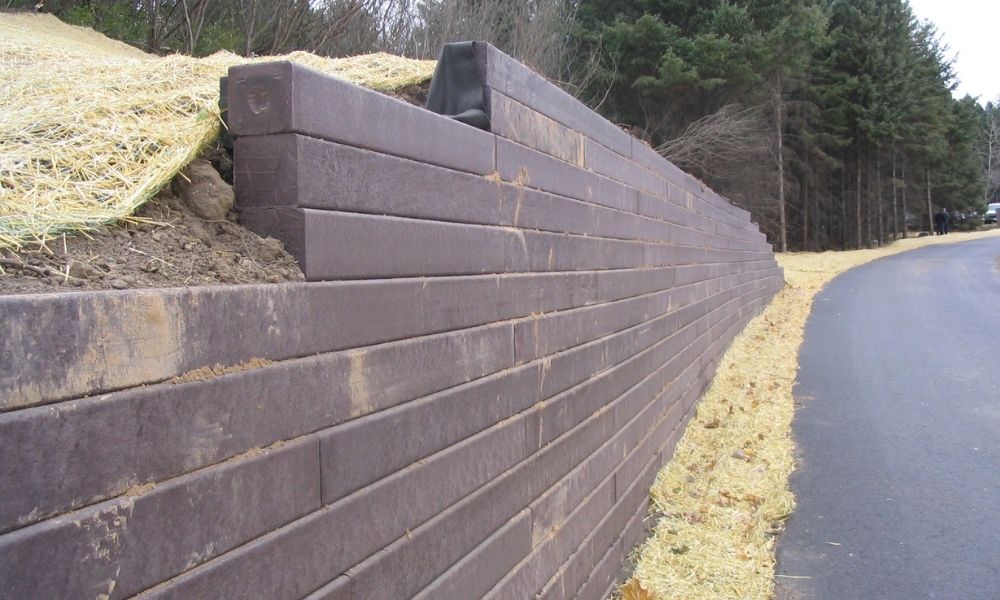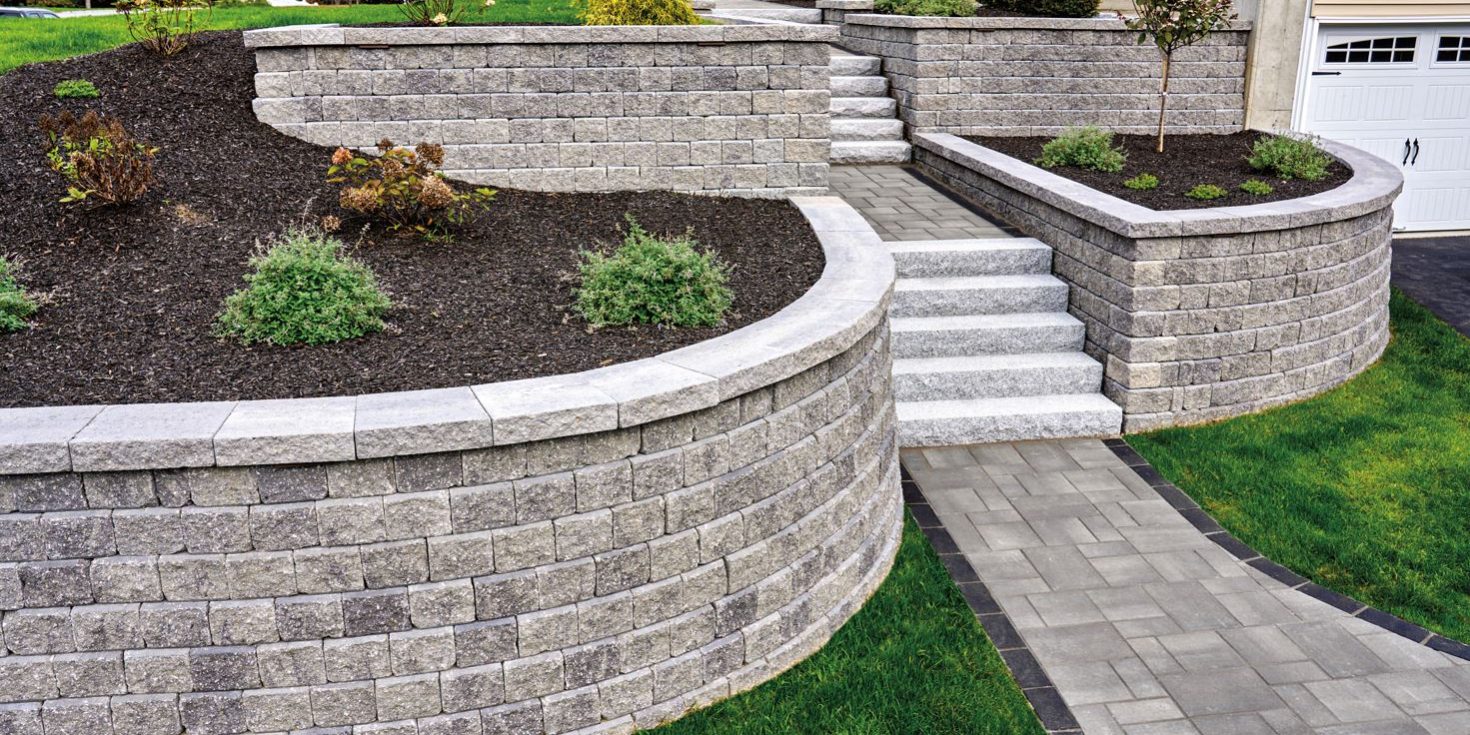Ten Must-Know insights about OKC Precision Retaining Walls every property owner should know
Ten Must-Know insights about OKC Precision Retaining Walls every property owner should know
Blog Article
The Essential Overview to Recognizing the Functionality of Retaining Walls
When it comes to handling sloped landscapes, retaining walls are essential. What types of retaining walls are offered, and how do you choose the appropriate materials?
What Are Retaining Walls and Their Purpose?
Retaining walls are necessary structures developed to hold back soil and stop disintegration, specifically on sloped landscapes. They supply stability to your building, ensuring that soil remains in area and preventing prospective landslides. When you think of a maintaining wall surface, consider its function in taking care of water overflow, which can wear down dirt with time. Without these walls, you may face expensive damages to your landscape and foundation.
Furthermore, retaining walls can develop functional areas in your backyard. By leveling out a sloped area, you can gain much more useful outside area for gardening, patios, or play areas. The layout and products you choose can enhance your building's appearances, making it visually appealing.
Eventually, understanding the objective of retaining walls helps you value their significance in landscape administration (OKC Precision Retaining Walls). They not just secure your residential or commercial property but additionally contribute to the general elegance and functionality of your outdoor area
Kinds Of Retaining Walls: An Overview
When it pertains to handling soil and water runoff in your landscape, knowing the different sorts of retaining walls can help you make an enlightened choice for your building. Gravity walls depend on their weight to keep back soil, making them a sturdy choice for smaller inclines. Cantilever walls, on the other hand, use a lever-like layout, which permits them to support extra substantial lots with less product. For more facility surfaces, secured walls give additional stability by using cable televisions secured right into the ground. Ultimately, there are modular block walls, which use adaptability and convenience of installation with interlocking blocks. Each type has its benefits and applications, so think about factors like dirt conditions, height demands, and aesthetic choices before making your choice. Comprehending these options will encourage you to improve your landscape successfully while protecting against disintegration and handling water runoff.
Secret Materials Used in Retaining Wall Surface Building
To develop a durable and efficient retaining wall, picking the right materials is necessary. You'll find that concrete is a popular selection because of its toughness and stamina. Precast concrete obstructs offer flexibility in style, while put concrete offers a seamless appearance. If you prefer an even more all-natural look, stone or block can include visual allure and blend with the landscape.
Timber is an additional choice, specifically for smaller sized walls, but remember it may not last as long due to decay. Steel and gabion walls, which utilize cable mesh full of rocks, are additionally efficient for details situations. Each product has its own benefits and downsides, so consider your wall's function, place, and budget. Eventually, the best product will improve the wall's security and longevity, ensuring it fulfills your demands while standing the test of time.

Style Factors To Consider for Effective Retaining Walls
Creating an efficient retaining wall involves mindful consideration of several crucial variables, as the wall must stand up to both upright and side forces. Analyze the dirt kind and its properties; cohesive dirts act in different ways than granular ones. You'll likewise intend to determine the elevation of the wall, as taller walls require more durable design solutions.
Following, take into consideration water drainage. Appropriate water drainage stops water buildup behind the wall surface, minimizing stress and possible failing. Integrate weep openings or water drainage pipelines for reliable water administration.
Additionally, consider the products you'll make use of. Different products, like concrete, rock, or wood, deal differing strengths and aesthetics.
Finally, don't neglect concerning regional regulations and codes. They frequently determine layout criteria and building and construction techniques. By dealing with these factors to consider, you can guarantee your retaining wall surface is not only practical but also resilient and safe.
Applications of Retaining Walls in Landscape Design and Building And Construction
Retaining walls serve a crucial role in both landscaping and building and construction, as they help handle modifications in official statement elevation and prevent soil disintegration. In landscape design, you can use them to create stunning terraced yards, enabling you to optimize your outdoor space while including aesthetic interest. They additionally assist define areas, such as paths or flower beds, boosting your landscape's total layout.
In building, retaining walls give security to frameworks improved sloped land, assuring security and toughness. They're often used in roads and commercial buildings to handle earth movement and drainage efficiently. By stopping dirt from changing, retaining walls shield foundations and keep the integrity of your building projects.
Whether you're aiming to enhance visual allure or assurance architectural stability, retaining walls use functional services that can considerably benefit your landscape and building endeavors. Embrace their versatility to accomplish both aesthetic and useful objectives.
Maintenance Tips for Long-Lasting Retaining Walls
To maintain your retaining walls in great shape, routine assessments and prompt repairs are crucial. You also require to ensure proper drain solutions to avoid water build-up, which can deteriorate the structure. Handling plant life around the walls will assist preserve their integrity and expand their lifespan.

Routine Maintenances
While you might assume your retaining wall surface can stand solid on its very own, normal evaluations and prompt repair work are important for its long life. Look for any kind of moving in the soil surrounding the wall surface, as this can suggest much deeper problems. By being proactive about inspections and repair work, you'll assure your retaining wall surface remains sturdy and functional for years to come.
Correct Drain Solutions
Efficient drain is crucial for maintaining the honesty of your retaining wall surface, as water buildup can bring about significant structural concerns. To assure correct drainage, mount weep holes at normal periods along the wall. These tiny openings allow excess water to get away, stopping pressure buildup behind the wall surface. You need to also consider adding a drain pipe at the base of the wall surface, routing water far from the structure. Use gravel backfill to promote drainage and lower dirt saturation. On a regular basis examine and clear any particles from drainage systems to keep circulation. By executing these solutions, you'll improve the long life and stability of your retaining wall surface, safeguarding it versus potential damage brought on by water build-up.
Plants Management Techniques
Healthy plants can play a vital role in the long life of your retaining wall surface. To ensure its effectiveness, you'll wish to manage the plant life around it very carefully. Start by picking ingrained plants that aid maintain the see this dirt without causing pressure on the wall - OKC Precision Retaining Walls. On a regular basis check for invasive species that can threaten your wall's honesty.
It's essential to avoid overwatering, as too much dampness can deteriorate the wall's structure. By carrying out these greenery monitoring approaches, you'll support your retaining wall's sturdiness and boost the surrounding landscape's charm.
Typical Problems and Solutions for Retaining Walls
When it concerns retaining walls, soil disintegration and water drainage concerns can create major migraines. You need to guarantee your wall is appropriately designed to avoid erosion and has an effective drain system in position. Allow's discover some typical troubles and their remedies to maintain your retaining wall surface tough and useful.
Soil Disintegration Avoidance
Soil erosion can be a substantial obstacle for retaining walls, especially if not effectively dealt with. When dirt deteriorates, it can weaken the wall surface's security, leading to potential failings. By taking these positive steps, you can substantially improve the durability and effectiveness of your retaining wall surface versus soil disintegration.
Drainage System Importance
A reliable water drainage system is important for the effectiveness and long life of retaining walls. Without correct water drainage, water can build up behind the wall surface, developing extreme pressure that could bring about architectural failure. You might observe bulging or breaking, which signals the demand for instant interest. To avoid these problems, consider installing weep openings, which enable water to run away, or a perforated drainpipe that reroutes water far from the wall surface. On a regular basis examine for obstructions in your water drainage system, as particles can site link hinder its efficiency. Preserving proper water drainage not only secures your retaining wall yet likewise guarantees the surrounding landscape continues to be secure. By remaining aggressive, you can avoid costly repair services and extend the life of your retaining wall.
Often Asked Concerns
Exactly How Do Retaining Walls Influence Drain Solutions?
Retaining walls can substantially affect water drainage systems by redirecting water circulation. They protect against soil erosion and take care of groundwater levels, making sure security. If you're planning construction, take into consideration just how they'll connect with your water drainage style for excellent outcomes.
Can Retaining Walls Be Installed on Inclines?
Yes, you can mount retaining walls on inclines. They assist maintain the dirt and prevent erosion. Just assure appropriate drain and pick the right materials to handle the pressure from the soil behind the wall surface.
What Is the Life expectancy of a Normal Retaining Wall?
A typical retaining wall surface lasts around 20 to 50 years, relying on products, upkeep, and environmental problems. You ought to on a regular basis evaluate it to ensure its long life and deal with any issues without delay to avoid expensive repairs.
Are Allows Required for Building Retaining Walls?
Yes, you normally require authorizations for constructing retaining walls. Inspect your neighborhood building ordinance and guidelines to guarantee compliance. It's important to protect the ideal consents before starting your task to stay clear of potential penalties or concerns.
Just How Do Retaining Walls Influence Building Worth?
Retaining walls can favorably influence your residential or commercial property value by boosting visual appeals, preventing erosion, and producing functional exterior area. OKC Precision Retaining Walls. They also demonstrate great land administration, making your property a lot more attractive to prospective customers in the marketplace
Report this page